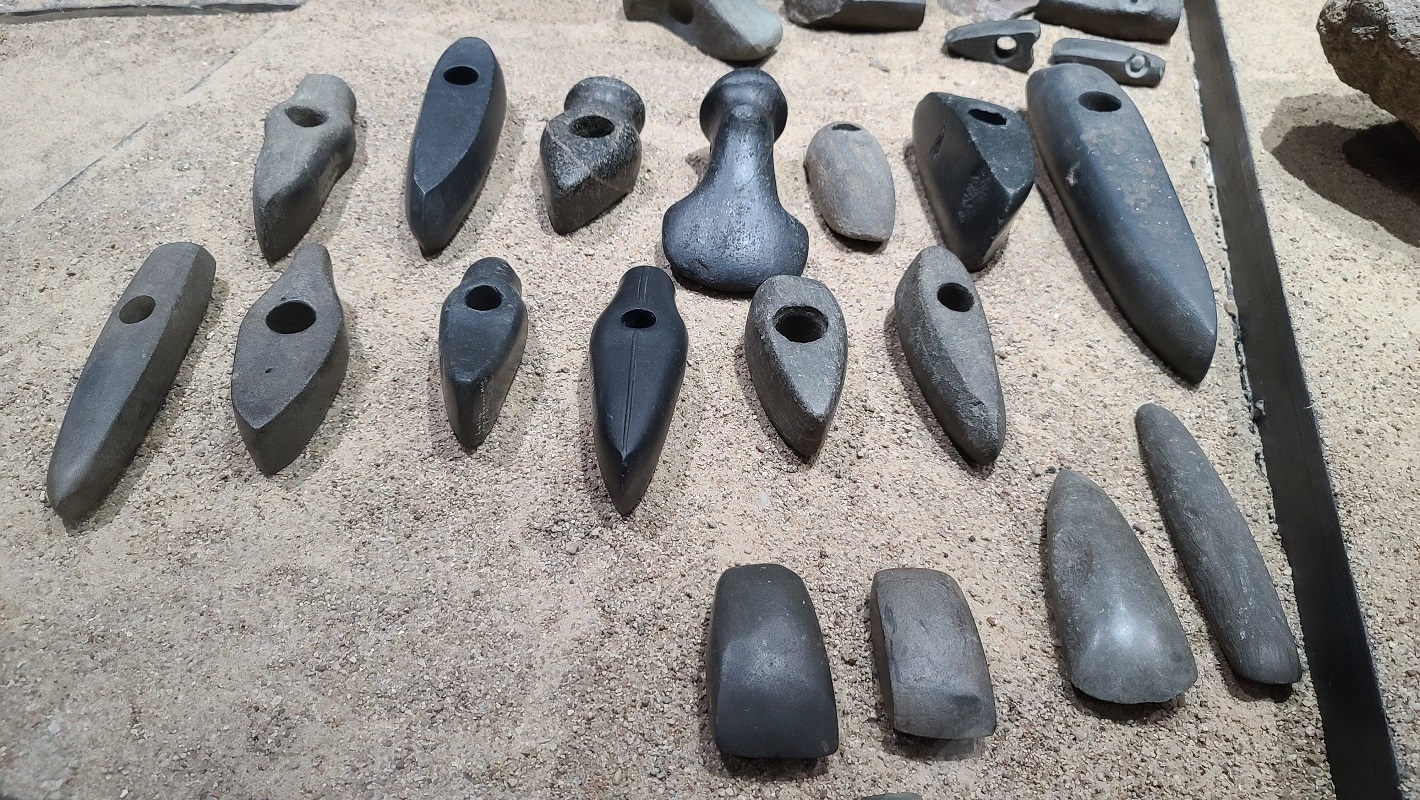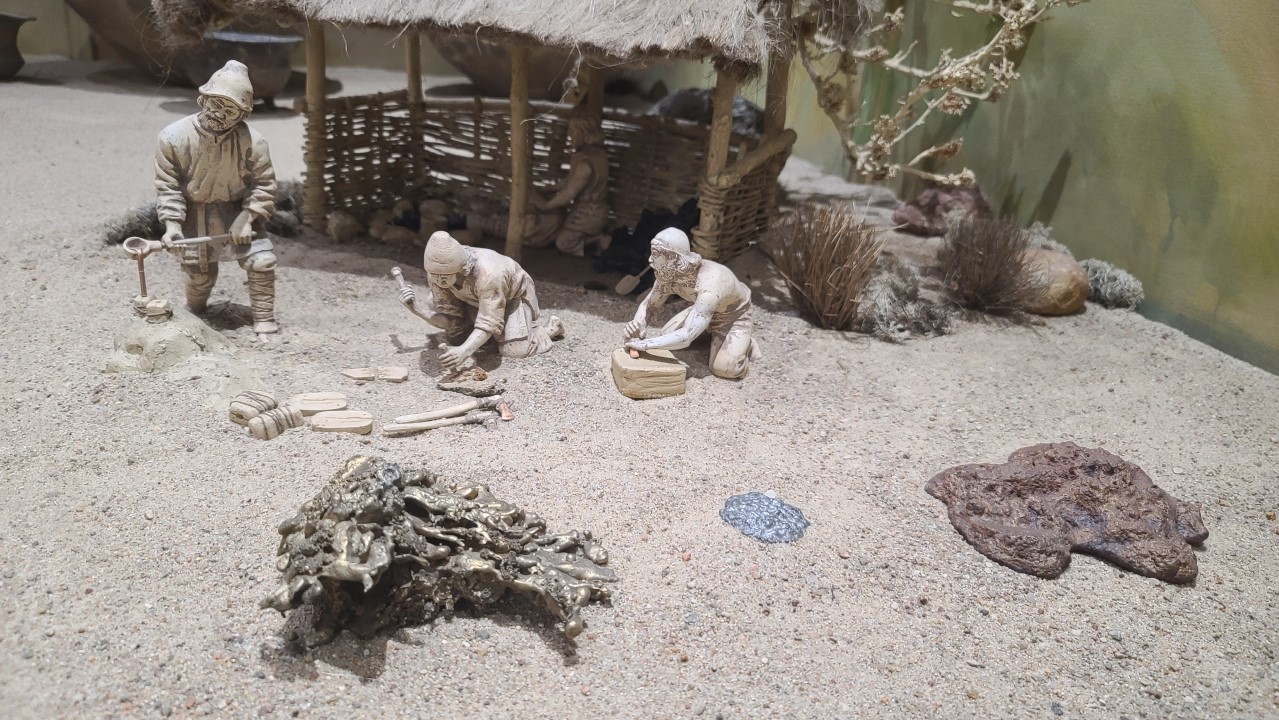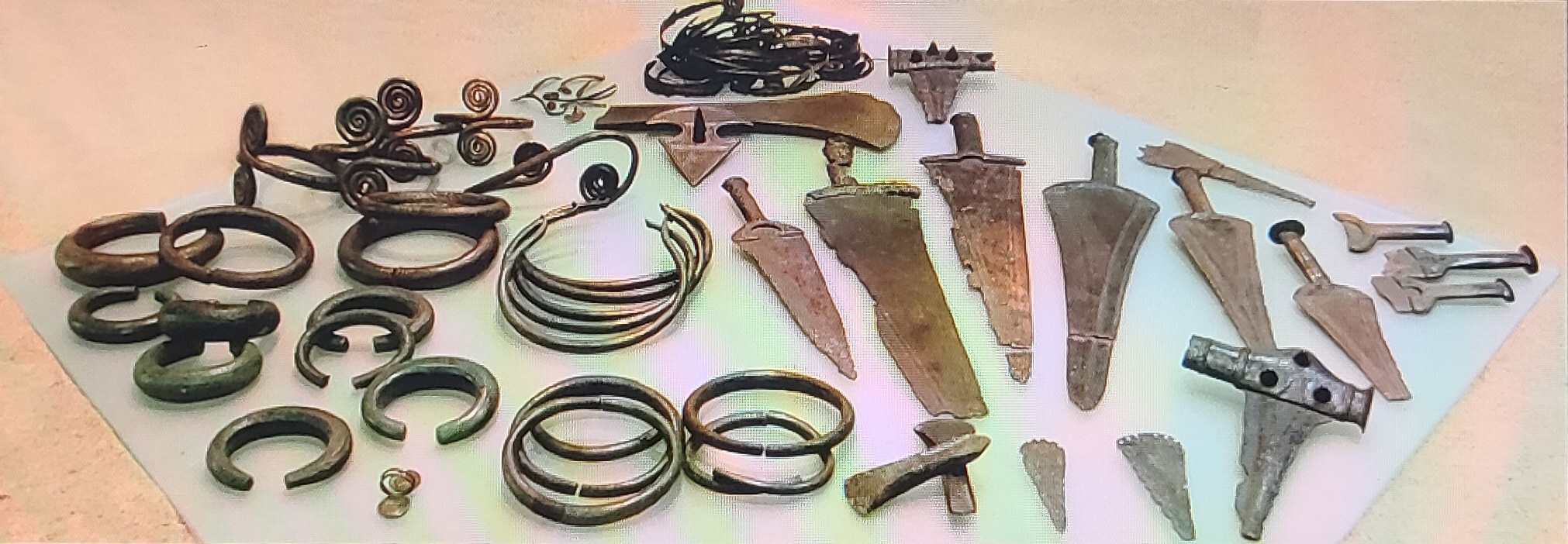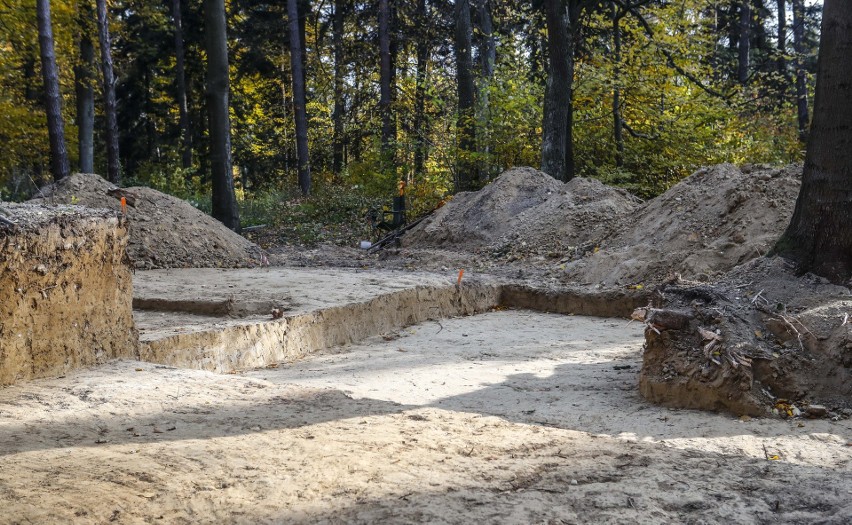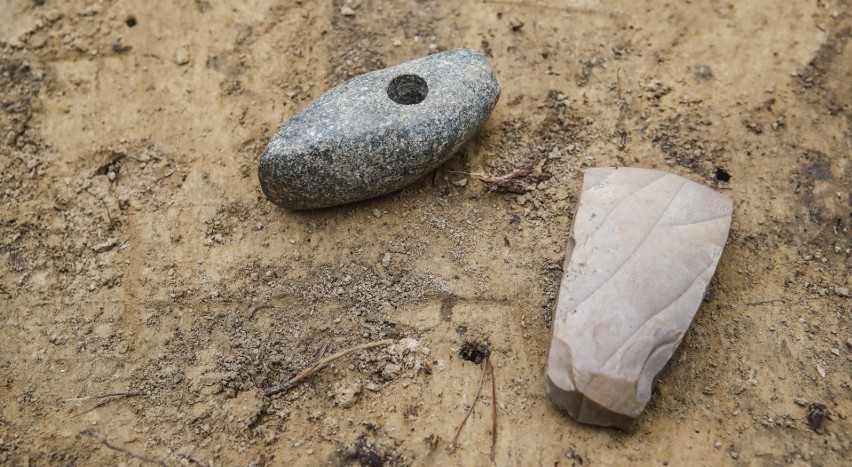Corded Ware Culture
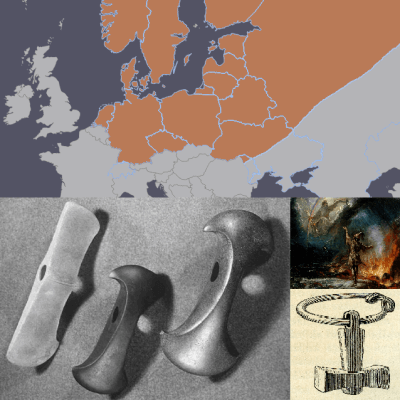
This culture existed from 2900 BC to 2300 BC. Its expansion reached the territory of modern day Netherlands, Belgium, Germany, Norway, Denmark, Sweden, Finland, Estonia, Poland, Czech Republic, Lithuania, Latvia, Belarus, Ukraine and European part of Russia.
Traces of emmer, common wheat and barley were found at a Corded Ware site at Bronocice in South-east Poland.
Wheeled vehicles (presumably drawn by oxen ) are in evidence, a continuation from the Funnelbeaker Culture era.
💀 They buried their dead in a single grave with body placed on side and sprinkled with ochre. Males on the right side and females on the left side of their body. Some graves contained the additional bones of: a dog and a swine
Some graves were in a form of a kurgan (tumulus). This is a shared aspect with yamna Culture. In 2011 AD in Mirocin, Poland there were unearthed 3 princely kurgan graves from around 3000 BC. One of them contained 7 ceramic pots, 3 flint battle axes and 6 arrowheads, 20 copper pieces of ornaments for clothing. It is a similar type of burial to that of the village Szczytna near Pawłosiów. 💀
Around 2800 BC the people of the Corded Ware Culture began excavating flint in mines near Краснасельскі (Krasnaselski; Polish: Krasne Sioło) near Volkovysk, Belarus. Flint workshops and multicultural sites were located near the shafts, those served as a settlement for the miners and as a place where the raw material was processed[1]. The Krasnaselski flint mine was in use until the beginning of the Early Bronze Age.
Words common mostly among Baltic-Slavic-Germanic languages are: SIlVER , lAND, SWINE, lIUDI, lAX, BEARD, YEAR, STRIKE, KERM, THOUSAND, RYE, LJUGA, KUNIGAS
Genetics
A study from 2018 by Mathieson et al. included a genetic analysis of a male buried at Aleksandriya, Kupryansk, Ukraine from around 4000 BC, ascribed to the ancestral Sredny Stog Culture. He was found to be carrying the paternal haplogroup R1a1a1 (R1a-M417, R1a-Z645) and the maternal haplogroup H2a1a. He carried about 80% Western Steppe Herder (WSH) ancestry and about 20% Early European Farmer (EEF) ancestry. This Sredny Stog male is the first steppe individual found to have been carrying EEF ancestry. As a carrier of the 13910 allele, he is the earliest individual ever examined who has had a genetic adaptation to lactase persistence.
The Western Steppe Herder (WSH) genetic cluster was a result of mixing between Eastern Hunter-Gatherers (EHG) from Eastern Europe and Caucasian Hunter-Gatherers (CHGs). This mixing appears to have happened on the eastern Pontic–Caspian steppe starting around 5000 BC. The WSH ancestry found in the Sredny Stog Culture is similar to that of the Khvalynsk Culture, among whom there was no EEF admixture. Males of the Khvalynsk Culture carried primarily the paternal haplogroup R1b, although a few samples of R1a, I2a2, Q1a and J have been detected.
Succeeding Yamna males however, have been found to have carried only R1b and I2. This is similar to the males of the Dnieper-Donets Culture, who carried R and I only and were exclusively EHGs with Western Hunter-Gatherer (WHG) admixture. The results suggest that the Yamna emerged through mixing between EHG and WHG males, and EEF and CHG females. This implies that the leading clans of the Yamna were of EHG paternal origin, which means that the Indo-European was the language of the Eastern European Hunter-Gatherers (R1 Y-DNA haplogroup).
As modern DNA tests have shown, the Corded Ware Culture has been established mostly by the people from the Yamna Culture (75% of their autosomal DNA). Y-DNA haplogroups of Corded Ware were mainly R1a with the majority being of R1a-Z645 subclade and one R1a-Z283. Around 2900 BC the Corded Ware Culture already spread to Bohemia in the territory of modern day Czech Republic. The haplogroups detected in that time and area were mainly R1b-L151 (6 out of 11) and one branch was determined to be ancestral to R1b-P312, the dominant Y-DNA in the Bell Beaker Culture[2]. The women of the Globular Amphorae Culture in the territory of Poland were taken by the invading Corded Ware Culture Indo-Europeans towards South to Czechia and these womens' mtDNA and autosomal DNA was detected in the Bohemian samples around 2900 BC[2].
In Scandinavia the transition from the preceding Neolithic period Hunther-Gatherer societies was rapid and represents a dramatic termination of Hunther-Gatherer traditions. It has been argued that the transformation is tied to initial migrations of people to the Western coast of Norway from the Bell Beaker Culture and Corded Ware Culture areas, possibly from Northern Jutland around 2800 BC.
The fact that two Latvian Hunter-Gatherer Y-DNA haplogroups have been characterized as belonging to R1b-M269 suggests that both subclades of R1 were present in the Baltic area before the expansion of the Corded Ware Culture. All four of the Estonian Corded Ware Culture individuals could be assigned to the R1a-Z645 subclade of haplogroup R1a-M417 which together with N is one of the most common Y chromosome haplogroups in present-day Estonians at 33% of male population. Importantly this R1a lineage is only distantly related to the R1a5 lineage found in the Estonian Comb Ceramic Culture (CCC) sample from 3600 BC. The R1a1-M459 was also found in the so called Steppe Maykop (Maikop) region around 3500 BC[3].
Middle Neolithic Northern European populations composed of admixed WHG and EEF survived but were largely excluded from Corded Ware cemeteries and from marriage into the Corded Ware population. Even centuries after the initial migration the Corded Ware population at Esperstedt, dated to 2500 BC – 2400 BC, still exhibited 70% – 80% Yamna (Steppe) genes, although individual variations in the extent of local admixture were apparent.
Autosomal DNA tests also indicate that the Yamna migration from the Steppes introduced a component of ancestry referred to as Ancient North Eurasian admixture into Europe (but not Eastern Europe). Ancient North Eurasian (ANE) is the name given in genetic literature to a component that represents descent from the people of the Mal'ta-Buret' Culture (22000 BC) or a population closely related to them. The Ancient North Eurasian genetic component is visible in tests of the Yamna people as well as modern day Europeans, but not of Western or Central Europeans predating the Corded Ware Culture.
The individuals associated with the Corded Ware Culture and the Yamnaya horizon were assigned to mtDNA lineages common among modern day West Eurasian haplogroups: H, I, J, T, U2, U4, U5, W, X. Individuals associated with the Eneolithic and Yamnaya cultures were assigned to mtDNA haplogroups: U2e1a1, U5a2b, H2a1 and U5a1i1, U4c1, W3a1, W3a1a. Other Bronze Age individuals from the Western Pontic region belonged to mtDNA X4 (two individuals associated with Catacomb Culture) and J2b1a, J1c2m, H1e (three individuals associated with Babyno Culture). Individuals associated with the Corded Ware Culture were assigned to mtDNA haplogroups: H, H6a, H15a1, H2a2, H1e, U4, U4b1a1a, U4a2f, W5b, U5a1b, I4a and T2e[3].
The R1a-M417 (R1a-Z645) appeared in Bohemia (Czechia) before the times of Unetice Culture (2000 BC) most probably from the Northern Europe near the area of Latvia and Scandinavia (area related to the Battle Axe Culture region of the Corded Ware Culture). It was also connected to the overthrow of earlier Bell Beaker Culture lineages in Bohemia[2]. This could also be the indication of the earliest Y-DNA ancestor of the nowadays most common R1a-M458 haplogroup in the Central Europe, which might already been present in that area in the times of Lusatian Culture.
Corded Ware Culture also shows genetic affinity with the later Sintashta Culture. For example its R1a-Z93 Y-DNA haplogroup originated in modern day Carpathian Mountains region of Southern Poland and Western Ukraine and later migrated to Fatyanovo-Balanovo Culture (ancestral to the Sintashta Culture, Tarim Mummies and Vedic Culture) in the territory of what is modern day Northwestern Russia[5].
Gallery Of Artifacts
Religion
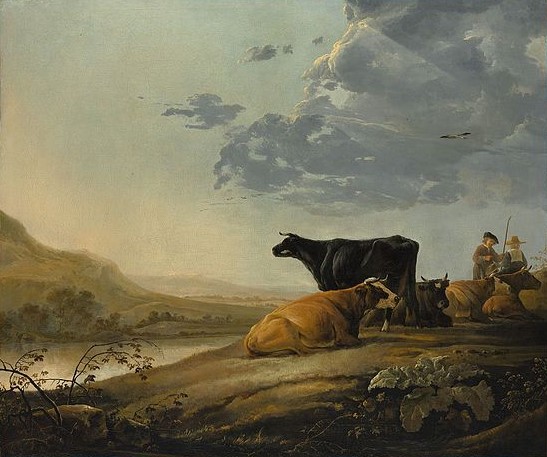
They most probably believed in a myth about the freeing of the cows from the moist place of Vala. There are several hymns in the Rig Veda describing this event:
2.12.3: Who slew the Dragon, freed the Seven Rivers, and drove the kine forth from the cave of Vala, Begat the fire between two stones, the spoiler in warriors' battle, He, O men, is Indra.2.15.8: Praised by the Angirases he slaughtered Vala, and burst apart the bulwarks of the mountain. He tore away their deftly-built defences. These things did Indra in the Soma's rapture.
8.14.7: In Soma's ecstasy Indra spread the firmament and realms of light, when he cleft Vala limb from limb.
10.68.6: Brhaspati, when he with fiery lightnings cleft through the weapon of reviling Vala, consumed him as tongues eat what teeth have compassed: he threw the prisons of the red cows open.
1.11.5: Lord of the thunder, thou didst burst the cave of Vala rich in cows. The Gods came pressing to thy side, and free from terror aided thee.
1.62.4: Mid shout, loud shout, and roar, with the Navagvas, seven singers, hast thou, heavenly, rent the mountain; Thou hast, with speeders, with Dasagvas, Indra, Shakra, with thunder rent obstructive Vala.
The Finnish goddess of water, lakes and seas Wellamo from Kalevala could also be a remnant of that belief. Vellamo has magical cows that live on underwater fields. Sometimes, during the morning mist, she brings her cows above the surface to eat water hay. Vellamo wears a blue dress that is made from sea foam. The name "Vellamo" comes from the Finnish word "velloa", which means "movement of water and waves".
Hades possessed a herd of immortal, sable-black cattle which roamed the asphodel fields in the care of the herdsman Menoites. In older Greek myths the realm of Hades is described as misty and gloomy. In the story of Zeus battling the giant monstrous serpent Typhon during or after the Titanomachy, Hesiod's Theogony describes Hades as cowering down below in the Underworld while Zeus is busy hurling thunder bolts and battling Typhon to take his place as king of the Olympian gods. In other myth Hermes hid the dead cattle from Apollo in a cave.
Archaeozoological and genetic data indicate that cattle was first domesticated from wild aurochs (Bos primigenius) around 8500 BC. There were two major areas of domestication: one in the Near East (specifically central Anatolia, the Levant and Western Iran), giving rise to the taurine line, and a second in the area that is now Pakistan, resulting in the indicine line. Modern mitochondrial DNA variation indicates the taurine line may have arisen from as few as 80 aurochs tamed in the upper reaches of Mesopotamia near the villages of Çayönü Tepesi in what is now Southeastern Turkey and Dja'de el-Mughara in what is now Northern Syria.
This means that the earliest possible population to create this myth would be Anatolian Hunter-Gatherers who also mixed with Caucasian Hunter-Gatherers. Earlier in history they built the Gobekli Tepe temple around 11000 BC. The domestication does not mean that the cattle was their main source of wealth because they also depended on other animals like goats and sheep. Cattle and sheep were far more significat for the Herders living in the Steppes (WSH), who did not eat grains and even if they had some Anatolian Hunter-Gatherer DNA through Early European Farmer influence, then the majority of their myths would come from the Eastern European Hunter-Gatherer beliefs that switched to the pastorialist (herding) economy.
The Slavic God of the Underworld Veles (Nyia) could be connected to bulls or maybe waves. The words for water wave in Balto-Slavic languages are: Bulgarian: вълна́ (vǎlná), Polish: fala, Old Polish: przewał, wełna, Russian: волна́ (volná), вал (val), Slovene: val, Belarusian: хва́ля (hválja), Latvian: vilnis, Lithuanian: vilnis, German: Welle, Romanian (Dacian): val. All those words could also be connected to a word "vele" meaning death. In Sanskrit वलय (valaya, falaia) means "coil", "enclosure", "cloud", "cavern", "cave", and वाल (vala) means "the tail of a mammal".
Myths presented above can be condensed into a single Corded Ware Culture belief that the Thunder God killed the Death God and his Mighty Serpent (probably Draught) and then brought humanity the wealth (cows) and running water gained from the opposing god.

